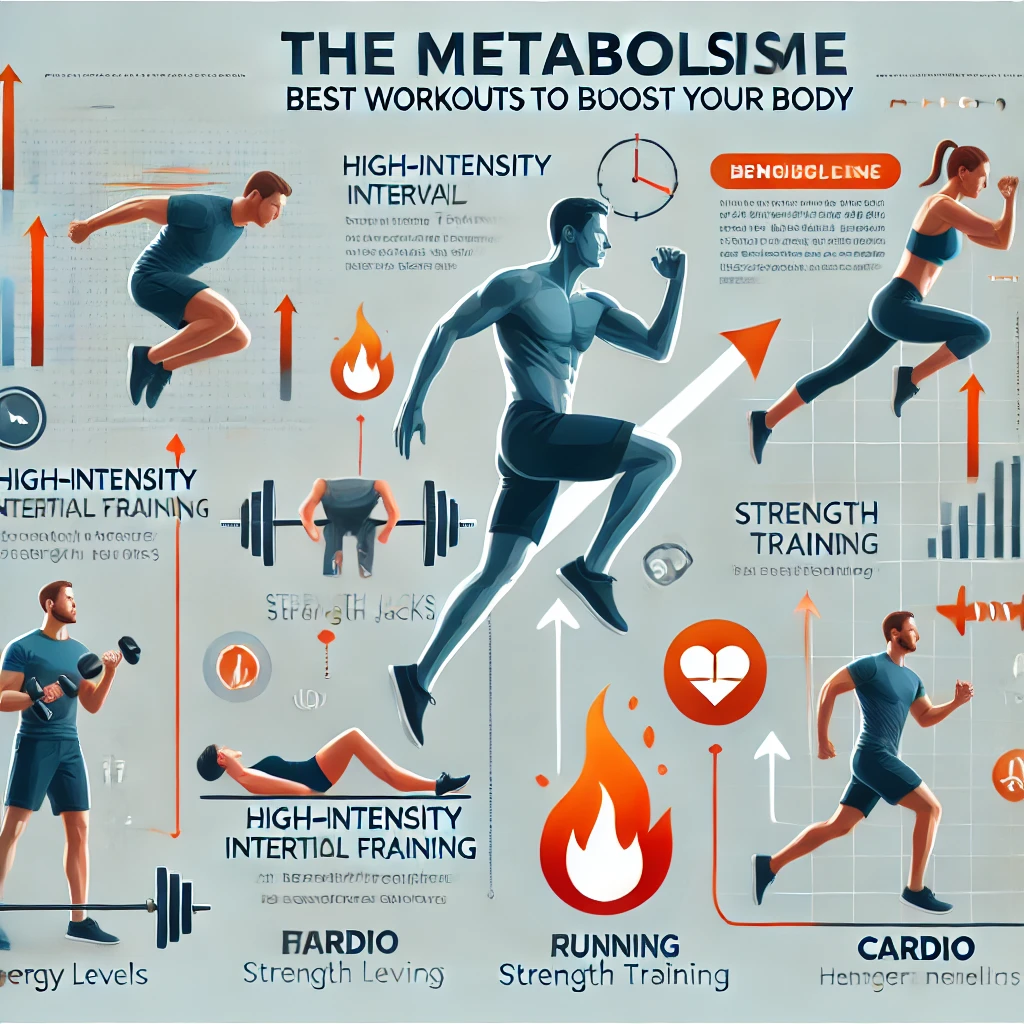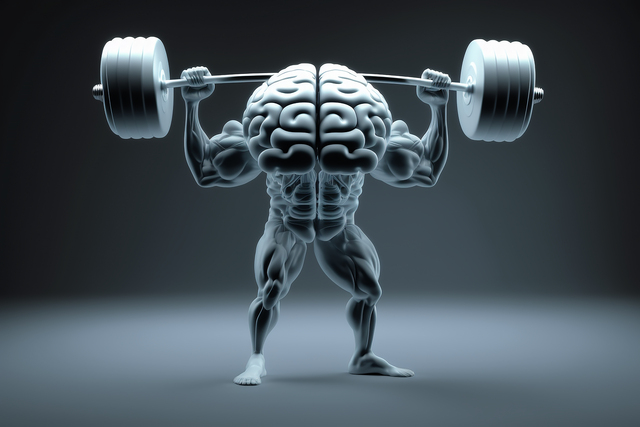Introduction
It’s time to rev up your body’s engine! If you’re looking to improve your overall health, energy levels, and weight management, focusing on the best workouts to boost your metabolism is a must. A well-functioning metabolism not only helps you burn calories efficiently but also supports various bodily functions. Ready to learn which workouts pack the most punch for your metabolism? Let’s dive in!

What is Metabolism?
Metabolism refers to the chemical processes within your body that convert food and drink into energy. It’s essential for maintaining life, fueling everything from breathing to physical activity. A faster One helps your body burn more calories at rest and during activity, making it easier to manage weight and stay energetic.
Why Boosting Your Metabolism Matters
Boosting your metabolism brings a host of benefits. From maintaining a healthy weight to increasing energy levels and even enhancing mood, a faster metabolism contributes to overall well-being. Regular workouts that target metabolic rate can lead to improved cardiovascular health, stronger muscles, and a better quality of life.
The Best Workouts for Boosting Metabolism
High-Intensity Interval Training (HIIT)
HIIT workouts involve short bursts of intense activity followed by brief periods of rest. This type of training is highly effective in increasing your metabolic rate, even hours after the workout has ended—thanks to a phenomenon known as the afterburn effect or excess post-exercise oxygen consumption (EPOC).
Example HIIT Workout:
- Warm-up: 5 minutes of dynamic stretching
- 30 seconds of sprinting, 30 seconds of walking (repeat for 10 cycles)
- Cool down: 5 minutes of walking and stretching
Strength Training
Lifting weights or engaging in bodyweight exercises helps build muscle. Since muscle tissue burns more calories than fat, having more muscle mass can significantly boost your resting metabolic rate.
Effective Strength Training Exercises:
- Squats
- Deadlifts
- Bench presses
- Lunges
- Pull-ups
Aim for at least two to three strength training sessions per week to see the best results.

Cardio Workouts
Steady-state cardio and interval cardio can both contribute to a higher metabolism. Running, cycling, and brisk walking are excellent options. To maximize calorie burn, try incorporating interval training into your cardio routine.
Interval Running Plan:
- Warm-up: 5 minutes of light jogging
- Alternate 1 minute of fast running with 2 minutes of slow jogging for 20 minutes
- Cool down: 5 minutes of walking
Circuit Training
Circuit training is a mix of strength and cardio exercises performed in quick succession. This method keeps your heart rate up, ensuring you burn calories while also building muscle.
Sample Circuit Routine:
- 1 minute of push-ups
- 1 minute of squats
- 1 minute of burpees
- 1 minute of jumping jacks
- Repeat for 3-4 rounds with minimal rest
Plyometric Exercises
Plyometric workouts involve explosive movements that increase your heart rate and metabolic rate quickly. Examples include jump squats, box jumps, and burpee tuck jumps.
Example Plyometric Workout:
- 15 jump squats
- 10 box jumps
- 20 burpees
- Repeat 3 times
Supplementary Workouts
Yoga and Pilates
While not as intense as HIIT or strength training, yoga and Pilates help improve flexibility, muscle tone, and core strength, which can support metabolic health. Poses like the warrior sequence and plank can build muscle endurance.
Swimming
Swimming is a full-body workout that not only burns calories but also improves cardiovascular health. The resistance of water makes your muscles work harder, boosting your metabolism.
Tips to Maximize Metabolic Benefits
- Stay Hydrated: Water plays a vital role in metabolism, so drink plenty throughout the day.
- Eat Enough Protein: Protein requires more energy to digest, helping increase your metabolic rate.
- Get Adequate Sleep: Rest and recovery are essential for maintaining a healthy metabolism.
How Often Should You Work Out?
For optimal results, aim for a mix of strength training, cardio, and HIIT workouts, totaling about four to five days per week. This balance helps prevent burnout and maximizes the afterburn effect without overtraining.
Nutrition and Lifestyle for a Healthy Metabolism
Boosting your metabolism isn’t only about exercise. Incorporate lean proteins, whole grains, and healthy fats like avocado and nuts into your diet. Reduce processed foods and focus on whole, nutrient-dense meals.
Common Myths About Metabolism and Workouts
Myth: Only intense exercise boosts metabolism.
Reality: While high-intensity workouts are great, other activities like walking and yoga also support metabolic health.
Myth: Your metabolism slows down significantly as you age.
Reality: While age can impact metabolism, regular exercise and proper nutrition can counteract this effect.
Conclusion
Improving your metabolism is not only key to weight management but also a powerful way to enhance your overall energy and health. The metabolism refers to the processes through which your body converts food and drinks into energy. A higher metabolic rate means your body burns more calories even at rest, contributing to better stamina, sustained energy levels, and easier weight maintenance.
One of the most effective strategies to boost your metabolism is through targeted exercise routines. By incorporating various workout types into your schedule, such as High-Intensity Interval Training (HIIT), strength training, and cardio, you can stimulate muscle growth, burn fat, and optimize your metabolic rate.
High-Intensity Interval Training (HIIT) is renowned for its ability to keep your metabolism elevated even after your workout session ends, thanks to the afterburn effect (excess post-exercise oxygen consumption or EPOC). HIIT involves short bursts of intense exercise followed by brief rest periods, which helps maximize calorie burn and improve metabolic function. It’s especially beneficial for those with limited time, as sessions can be as short as 15-30 minutes but remain highly effective.
Strength training plays a pivotal role in metabolic health by building lean muscle mass. Muscle tissue is metabolically more active than fat tissue, meaning the more muscle you have, the more calories you burn throughout the day. Incorporating compound movements such as squats, deadlifts, and bench presses, which engage multiple muscle groups at once, can supercharge your metabolism.
Cardiovascular exercises like running, cycling, or swimming are excellent for maintaining heart health and contributing to overall calorie expenditure. While cardio may not build as much muscle as strength training, it enhances cardiovascular efficiency and endurance, aiding in a healthy metabolic rate.
FAQs
Q1:What type of workout is best for metabolism?
While various types of exercise contribute to metabolic health, HIIT and strength training stand out as the most effective for metabolism-boosting benefits. HIIT workouts not only improve cardiovascular health and stamina but also trigger a metabolic response that can last hours after a session. Strength training, on the other hand, promotes muscle growth, which is critical as muscle cells require more energy to maintain than fat cells, boosting the basal metabolic rate (BMR).
Q2: Can metabolism be boosted without exercise?
Yes, metabolism can indeed be enhanced without exercise, though physical activity is one of the most efficient methods. Strategies include:
- Diet Adjustments: Consuming protein-rich foods helps increase the thermic effect of food (TEF), which is the number of calories used to digest, absorb, and process nutrients. Lean meats, eggs, legumes, and dairy are particularly beneficial.
- Hydration: Drinking enough water can momentarily speed up metabolism. Studies show that drinking cold water can increase energy expenditure as the body uses calories to heat the water to body temperature.
- Adequate Sleep: Restful sleep is essential for metabolic regulation. Poor sleep patterns can lead to hormonal imbalances that slow metabolism and increase appetite.
- Small, Frequent Meals: Eating smaller meals more frequently can prevent the metabolism from slowing down. However, this approach should be balanced and in line with daily caloric needs.
Q3: How long does it take to see results?
The timeframe for visible results can vary greatly based on individual factors such as age, gender, starting fitness level, and consistency. However, most people who engage in consistent training and maintain a healthy diet start to see noticeable changes within 4-6 weeks. Strength gains, improved endurance, and slight body composition changes are among the first signs of progress. The key to lasting results is patience and maintaining a balanced approach to fitness and nutrition.
Q4:What are the best foods for metabolism?
Nutrition is a cornerstone for metabolic health. Some of the top foods that support metabolism include:
- Lean Proteins: Chicken, turkey, fish, and plant-based proteins like tofu and lentils help increase TEF and promote muscle repair and growth.
- Whole Grains: Foods like oats, quinoa, and brown rice are complex carbohydrates that provide sustained energy and require more effort to digest, boosting metabolism.
- Spicy Foods: Peppers containing capsaicin can temporarily increase metabolic rates by raising body temperature and enhancing calorie burn.
- Green Tea and Coffee: These beverages are known for their metabolism-boosting properties due to caffeine and antioxidants like catechins in green tea.
- Healthy Fats: Avocados, nuts, and fatty fish rich in omega-3s help regulate metabolism and support overall health.
Q5:Is it possible to overtrain and harm your metabolism?
Yes, overtraining can be counterproductive. Pushing the body beyond its limits without adequate rest can lead to overtraining syndrome, which manifests as chronic fatigue, impaired performance, hormonal imbalances, and a slower metabolism.
The body needs rest and recovery to repair muscles and adapt to training. Without sufficient rest, stress hormones like cortisol can become elevated, which may contribute to fat retention and decreased metabolic function. Active recovery days, including light activities like walking or yoga, and sufficient sleep are crucial to maintaining a high metabolism and overall health.
Incorporating These Insights for Long-Term Success
A successful plan for boosting metabolism blends exercise, nutrition, rest, and lifestyle adjustments. Here’s how to incorporate these pillars:
- Create a Balanced Workout Routine: Aim for 3-4 days of strength training and 1-2 days of HIIT or cardio. This combination helps build lean muscle while keeping cardiovascular health in check.
- Prioritize Nutrient-Dense Foods: Build meals around lean proteins, complex carbohydrates, and healthy fats. Avoid highly processed foods that can cause energy spikes and crashes.
- Hydrate and Sleep Well: Drinking water consistently and ensuring 7-9 hours of quality sleep each night support metabolic processes.
- Manage Stress: High stress levels can negatively impact metabolism. Practices like meditation, deep breathing, and relaxation exercises help keep stress under control.
By integrating these practices into your life, you can create a well-rounded approach that not only optimizes your metabolism but also enhances your overall quality of life.







